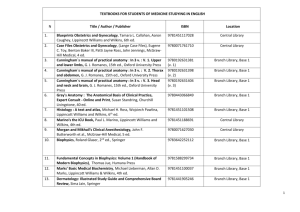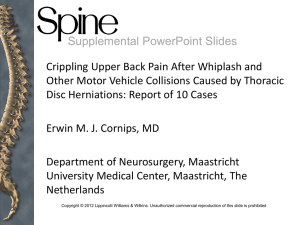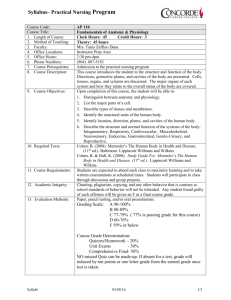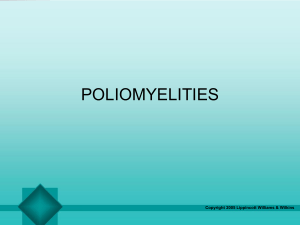Evaluation in cerebral palsy
advertisement
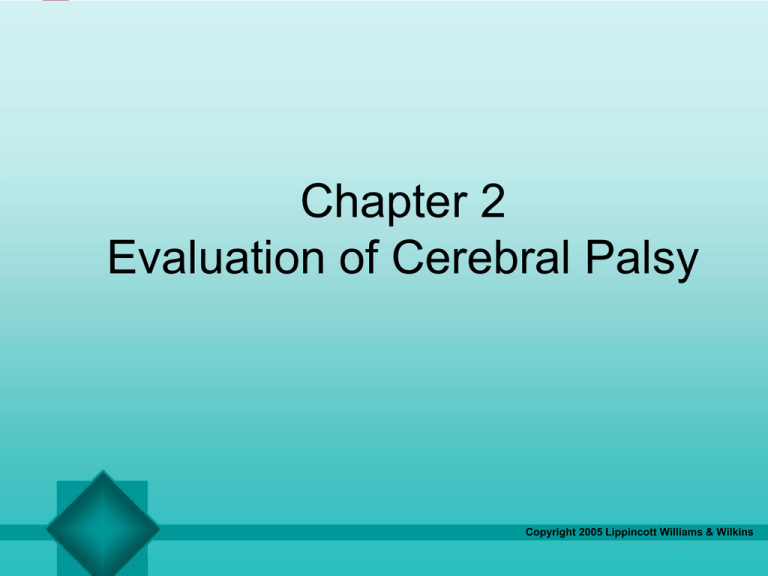
Chapter 2 Evaluation of Cerebral Palsy Copyright 2005 Lippincott Williams & Wilkins Definition of Cerebral palsy: It is neurodevelopmental disorder caused by non progressive lesion in single or multiple location of immature)before2 years) leading to persistent disorder in posture and environment in early infant life. Etiology: Prenatal (from conception to birth) a- Trauma b- Toxoplasma c- Radiation d- Drugs e- Pollution f- diabetics g- Viral infection h- German mdesis Perinatal (during delivery) a- Forceps causes brain damage b- Anoxia(No o2 in blood) - c- Hypoxia( decrease o2 in blood) d- pralopard umbilical cord Copyright 2005 Lippincott Williams & Wilkins 3 – postnatal causes: Jaundice ,Fever, Malnutrient, Trauma , Meningitis Types of Cerebral Palsy: 1- According muscle tone distribution (Topographic): a- Monopegia: one limb b- diaplegia: 4 limbs (Lower limbs more than upper limbs) c- Hemiplegia: half of the body d- Quadriplegia: 4 limbs e – Triplegia: 3 limbs f- Double Hemiplegia 2- According muscle tone disturbance: a- Spastic type: Quadriplegia b- Stegmus type ataxic type (rare) c- Dyskinesia type: involuntary movement affect basal ganglia due to jaundice D- Hypotonia : central forever Transient for certain period E- mixed type Copyright 2005 Lippincott Williams & Wilkins Assessment: Factors affecting the assessment: 1- Age 2- Developmental level 3- Degree of involvement(Severity) 4- Surrounding environment Main aim of evaluation to put proper program of treatment Team worker in assessment of C.P 1- pediatrition 2- neurologist 3- physical therapist 4- Occupational Therapist 5- Social Worker 6- Nutritionist 7- Dentist Defintion of evaluation : It is a process of collecting and organizing information to plan proper treatment POMR have 4 areas: 1- Data base 3- Initial Plane 2- problem list 4- Progress note 1- Data base All subjective and objective information collected on child Copyright 2005 Lippincott Williams & Wilkins Source: patient file Include a- Diagnosis title, type b- Referred from physician c- Frequency of session 2- History Talking; Personal History: Name Age by months Sex Present history Chief complain in wards of mother Past History Any disease or surgery not related to CP Family History: Consanguinity, Arrangement of child to his brothers Parents attitude about child, Any familiar cases Medical history: Anti epileptic drugs, muscle relaxant 3-Physical evaluation: Informal evaluation (general overview at patient) Formal evaluation (Functional test) Standardized evaluation (objective test like MRI, CT) Copyright 2005 Lippincott Williams & Wilkins • a- Informal evaluation • 1-posture to determine Tone (ex: flexion in upper limb indicate flexor hypertonia) persistent primitive reflex ASTNR 2- Movement or spontaneous motility of child: a- Initiation of movement: like hemiplegia initiate movement by non affected limb then affected limb b- Speed of movement: : like hemiplegia cerebral palsy have long latency of response due to lack of understanding directions 3- Asymmetry of movement: between up& low Limb, RT & LT Side 4- Associated movements or mirror of movement: When make action in one side other side make same action -----------inhabit isolated movemen 5- S Copyright 2005 Lippincott Williams & Wilkins 5- Associated disorder: a- Vision---- tested by attractive toy and he follow it by his head b- Hearing------ tested by attractive sound or startle reflex stimulus: sudden noise beside his ear Response: flexion in elbow and fist hand Age birth and continue c- Deformities and contracture Determine direction of deformity Determine degree of deformity: First degree : can be corrected actively Second: can be corrected passively Third: corrected only by surgery Copyright 2005 Lippincott Williams & Wilkins • Formal evaluation • 1- Muscle tone assessment: • Slight resistance or amount of tension that you feel when move muscle • • • Methods of assessment: 1- passive movement 2- Shaking to distal part in all direction 3- Postural fixation(sudden release of limb) • • • • • Passive movement performed in all 4 directions, constant speed, Rhythmic Determine : body part examined(upper limb, lower limb) Type of muscle tone (hypertonia, hypotonia) Distribution (flexor, extensor. Abductor, adductor) Spasticity has clasp knife phenomena increase resistance then suddenly release Factors affecting evaluation of muscle tone; 1-laughing 2- excitement 3- Surface 4- light 5- Sleeping 6- head position • • • Copyright 2005 Lippincott Williams & Wilkins 2)- Assessment of reflexive maturation 3)- Assessment of development by using Denver developmental Screening Test (DDST):include 4 components: 1- Gross Motor: the ability of the child to maintain and assume certain position such as sitting, rolling creeping 2- Fine Motor: hand manipulation, hand coordination, reaching, grasping 3- Language: lolling , pepping 4- Personal- social : How the child interact with environment DDST consists of 105 tasks in 4 areas Used for children from 1 month to 6 years Each task divide to 25, 50,75,90 % 25% of population able to perform this task in this month 90% not 100% because 10% of population are hanedicap Copyright 2005 Lippincott Williams & Wilkins • How to use DDST: • 1- Ask the mother about chronological age • • • • • • • 2- Ask the mother if he can do the task or not 3-Mark the task whenever make it 25, 50,75,90 CP child have scattering milestone that means he can do task before another task standing before sitting this is due to: a- The organization or systemic myelination of CNS b- Habits the child like to stand on toes by +ve suuporting not sitting How to measure scattering of milestone? put marks on last task he can do it and other mark on scattered task Summate both then divide them on two. • 4- Musculoskeletal assessment: determine degree of tightness by flexibility test • 1- soleus: put knee in flexion and make dorsiflexion if he cannot so he have tightness Copyright 2005 Lippincott Williams & Wilkins 2- Gastrocnemius: put knee in extension and make dorsiflexion if he cannot so he have tightness 3- Iliopsoas: make flexion hip and knee in one side if flexion hip occur on opposite side ------------tightness of Iliopsoas muscle 4- Hamstring Muscle Degree of deformities: 1st grade---------- Child can correct it actively 2nd grade----------Child can correct it passively 3rd grade----------- Child cannot correct it need surgical interference Assessment of gait in CP: Common types of gait in CP Spastic diaplegia: a- Mild or moderate type: Couch gait Description: Semi flexion in hip, adduction ,internal rotation hip and plantar flexion of ankle in both lower limb, slight bending in neck, trunk forward high guard in upper limb(abduction in upper limb with flexion elbow posterior pelvic tilt and very quick steps Copyright 2005 Lippincott Williams & Wilkins • • • Cause of gait: sitting position (W shape) sitting on his feet because of always working of hip extensors(gluteus Maximus and hamstring) Happits: he wants to lower himself to BOS. b- In sever type : scissor gait ( extension, adduction , internal rotation) • Because of sever extensor spasticity will stimulate +ve supporting reaction • 2- Spastic hemiplegia: • Circumduction gait by quadratus lambrum hike pelvis upward to clear foot from ground Patient will take long step by affected limb and short step by non affected limb to decrease time of bearing on affected limb • 3- Athetosis: Athetoid dance confliction between two reflexes : Flexor withdrawal and toe grasping reflex • 4- Ataxic: drunken gait wide BOS due to poor balance Copyright 2005 Lippincott Williams & Wilkins
